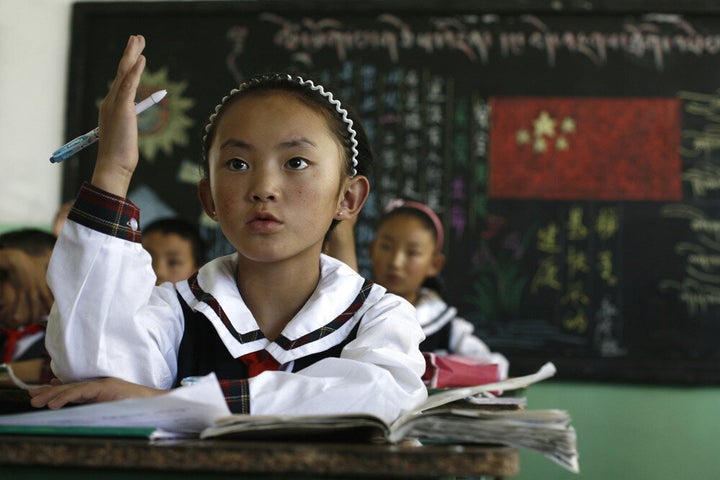
When governments gather for the annual IMF-World Bank meeting in Washington next week their agenda will be dominated by Europe's debt problems and economic recession. Crucial though these are, my concern is that critical issues that will determine our long-term future are being pushed to the sidelines. Nowhere is this more evident than in education.
The global crisis in education does not make headlines. It doesn't register in bond markets. And you don't see images of children starving for want of classrooms, books and teachers. This is a silent and invisible crisis. But make no mistake -- it is an emergency destroying lives on an epic scale, and holding back the economic progress of nations.
Headline numbers tell part of the story. In the midst of our increasingly knowledge-based global economy, there are 68 million children of primary school age out of school. Millions more drop out after just one or two years of education. While children in Britain receive on average around 14 years of education, their counterparts in the poorest parts of Africa average less than 4 years.
Shocking as these facts are, they understate the problem. Across Africa and much of South Asia, children are emerging from primary school unable to read, write or conduct basic numeracy tasks. Chronic shortages of teachers -- around 1 million in sub-Saharan Africa -- textbooks and classrooms all contribute.
Let's not forget that at the turn of the millennium, the world came together to promise that by 2015, every child would complete a full course of primary schooling, and progress is stalling.
It is education that fuels economic growth, productivity and innovation. Accelerated progress towards our education goal has the potential to raise the long-run growth potential of the poorest countries by around 2 percent annually, transforming their prospects for poverty reduction.
Education is also the fuel that drives advances in public health: on one estimate, getting all of Africa's girls into secondary school would cut child mortality in the region by 1.8 million. If aid donors want to achieve the Millennium Development Goals for child survival, they neglect education at their peril.
In Nigeria, half of the population is under 19, and 8 million children are out of primary school. Converting oil wealth into human capital through education could transform the country's future. But stripped of the employment prospects and hope that come with education, youthful populations can represent a demographic time-bomb.
Many governments have made extraordinary progress in delivering education. The advances registered by Ethiopia, Tanzania, Mozambique and Bangladesh, to name a few, are among the great success stories of the past 50 years. Far more has to be done, especially in reaching marginalized populations, closing gender disparities and improving quality. But the gains demonstrate a high order of political leadership.
The same cannot be said of aid donors. Delivering on basic education in the poorest countries would cost around $16 billion annually. Unfortunately, aid budgets have stagnated at around $3 billion -- and many donors have been cutting back.
France and Germany are the world's largest donors to education, but less than 10% of their aid goes to basic education in poor countries. Most of the remainder provides subsidies to French and German universities receiving overseas students.
The Fast Track Initiative (FTI), operating under the auspices of the World Bank, has achieved some important results, but it is delivering too little aid -- around $249 million in 2010 -- to too few countries, far too slowly.
There is overwhelming evidence from drought-prone areas in the Horn of Africa that hunger and rising child poverty is pushing children out of school. In the Dadaab refugee camp on the Kenya-Somali border, education provision is collapsing. Yet aid donors have failed to respond, undermining the efforts of parents trying to restore some sense of stability and hope to the lives of their children.
Nobody is suggesting that donors should switch aid from food to education. But children whose lives have been blighted by hunger surely do not deserve to be punished twice over by being deprived of an education that could lift them out of poverty.
In newly independent South Sudan -- a country with some of the world's worst education indicators -- young girls are statistically more likely to die in childbirth than get past third grade of primary school. Yet five years after a peace agreement, its children are still waiting for aid donors to get behind an education reconstruction plan.
Queen Rania of Jordan, Kofi Annan, Graça Machel and others have joined me in a high level panel to push Education for All. In New York on Tuesday, the heads of some of the world's largest companies will be forming the Global Business Coalition for Education.
Unlike some of the issues on the IMF-World Bank agenda, the education crisis has some simple solutions. The starting point is to transform the FTI into a properly-resourced, independent Global Fund for Education. This should then be the focal point for encouraging countries to step up their efforts to help deliver Education for All.
The fund would support the recruitment and training of teachers, deliver textbooks, and finance classroom construction. An FTI replenishment meeting planned for October should aim at capitalizing the fund at around $3-4 billion annually to 2015.
Modeled on the best practices of global health funds, this education fund would serve as a conduit for aid, but also a vehicle for engagement with the private sector. Playing a role in facilitating philanthropic contributions, it would also incentivize the use of information and communication technologies to train teachers, deliver 'e learning' opportunities and build classrooms for some of the world's poorest children.
This is an initiative with the power to deliver results and transform lives. Before the 2015 target drifts out of reach, all of us should remember a simple guiding principle -- you don't break a promise made to children.
